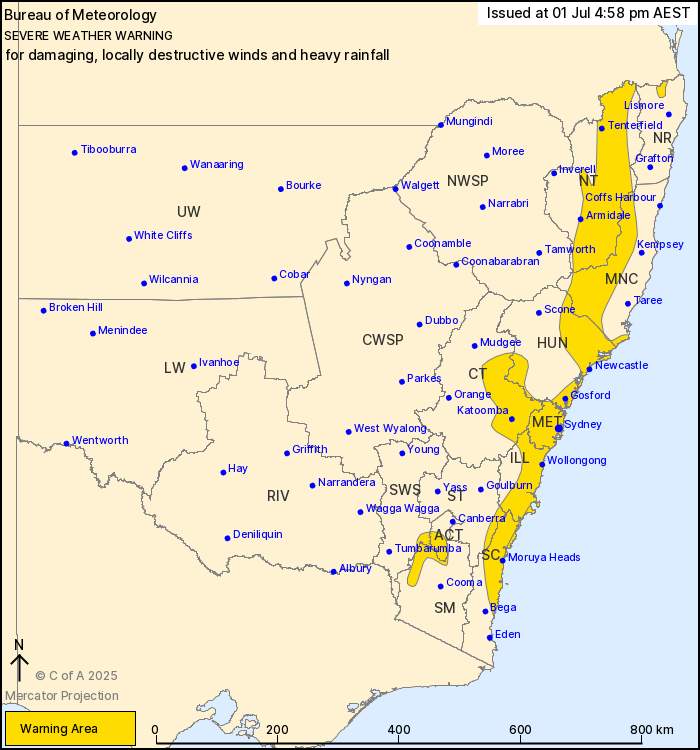Source: Bureau of Meteorology
For people in Metropolitan, Illawarra and parts of Mid North
Coast, Hunter, South Coast, Central Tablelands, Southern
Tablelands, Snowy Mountains, Australian Capital Territory, Northern
Tablelands, Northern Rivers and South West Slopes Forecast
Districts.
Issued at 4:58 pm Tuesday, 1 July 2025.
VIGOROUS COASTAL LOW TO BRING DAMAGING WINDS AND HEAVY RAINFALL TO
EASTERN NSW AND SOUTHERN ACT, WITH LOCALLY DESTRUCTIVE WINDS AROUND
JERVIS BAY AND SOUTH COAST.
Weather Situation: A vigorous complex low-pressure system is
currently located offshore of the Hunter Coast, gradually tracking
southwards towards before an expected northeast turn into the
Tasman Sea during Wednesday. Winds are expected to strengthen along
the central to northern Great Dividing Range, southern ranges and
ACT this evening. A moist southeasterly airstream is likely to
continue strengthening on the southern flank of the system this
evening, bringing heavy rainfall through the southern Illawarra,
South Coast and adjacent Southern Tablelands.
Locally DESTRUCTIVE WIND GUSTS with peak gusts in excess of 125
km/h are possible along the coastal fringe of the Illawarra and
South Coast this evening and overnight, roughly between Jervis Bay
and Moruya, with this risk easing during Wednesday morning.
HEAVY RAINFALL which may lead to FLASH FLOODING is expected to
develop in the Illawarra south of about Wollongong later this
evening, extending southwards towards Bega in the South Coast.
Six-hourly rainfall totals between 50 to 80 mm are likely, with
isolated totals up to 120 mm. Rain rates ease during Wednesday
morning.
DAMAGING SOUTH TO SOUTHWESTERLY WINDS averaging 60 to 70 km/h with
peak gusts of around 110 km/h are possible along coastal parts from
the South Coast to the Mid North Coast, including the Sydney
Metropolitan area. DAMAGING SOUTH TO SOUTHWESTERLY WIND GUSTS
around 90 km/h are possible in the remainder of the Sydney
Metropolitan area, parts of the Snowy Mountains and southern ACT,
eastern Central Tablelands and adjacent Hunter ranges.
Wind are expected to ease in western Sydney overnight, but the
DAMAGING WIND GUSTS may persist through to Wednesday morning in the
Central Tablelands and southern ranges, and may continue along the
coastal fringe through Wednesday.
Strong to DAMAGING WEST TO SOUTHWESTERLY WINDS averaging 55 to 65
km/h with peak gusts of around 90 km/h are likely to develop during
Tuesday evening about parts of the Northern Tablelands, the Mid
North Coast hinterland and about the Border Ranges from early
Wednesday morning, and are expected to continue through
Wednesday.
Impacts associated with the complex low will likely be on an
easing trend during Thursday, but pulses of increased winds and
rainfall associated with this system could continue to impact areas
of eastern NSW.
A separate Coastal Hazard Warning is also current for parts of the
NSW coast. Refer to: http://www.bom.gov.au/nsw/warnings/
Locations which may be affected include Newcastle, Gosford,
Sydney, Wollongong, Armidale, Nowra, Batemans Bay, Tenterfield,
Katoomba, Moruya Heads and Penrith.
The State Emergency Service advises that people should:
* Move vehicles under cover or away from trees.
* Secure or put away loose items around your house, yard and
balcony.
* Keep at least 8 metres away from fallen power lines or objects
that may be energised, such as fences.
* Trees that have been damaged by fire are likely to be more
unstable and more likely to fall.
* Report fallen power lines to either Ausgrid (131 388), Endeavour
Energy (131 003), Essential Energy (132 080) or Evoenergy (131 093)
as shown on your power bill.
* Don't drive, ride or walk through flood water.
* Keep clear of creeks and storm drains.
* If you are trapped by flash flooding, seek refuge in the highest
available place and ring 000 if you need rescue.
* Be aware that run-off from rainfall in fire affected areas may
behave differently and be more rapid. It may also contain debris
such as ash, soil, trees and rocks.
* After bushfires, heavy rain and the loss of foliage can make the
ground soft and heavy, leading to a greater chance of
landslides.
* Stay vigilant and monitor conditions. Note that the landscape
may have changed following bushfires.
* For emergency help in floods and storms, ring your local SES
Unit on 132 500.

01/Jul/2025 07:05 AM



